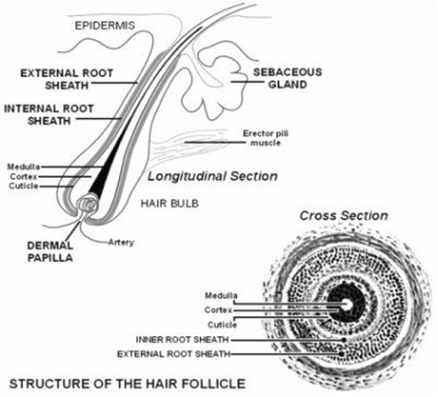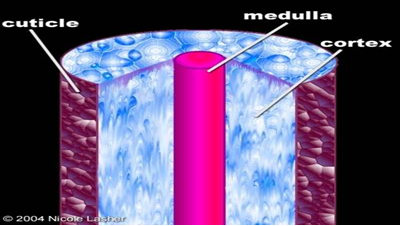The Anatomy and Structure of Hair
HAIR STRUCTURE
Hairs are elongated keratinized structures. Keratin is a special protein, which is resistant to wear and tear. It is the protein that also makes up the nails. Like other proteins in the body, keratin is also a large molecule made up of smaller units called amino acids. The amino acids are joined together in a chain, like beads on a string.
The diameter of a single hair fiber varies from person to person; but it is usually around 0.05 to 0.09 millimeters. (A few millions per inch)
The epidermis is the outermost layer of the skin. Each hair arises from an indentation on the epidermis. The hair has two parts:
- the hair follicle (important to Hair care and maintenance)
- the hair shaft. (important to hair grooming and dressing)
(1) HAIR FOLLICLE
The hair follicle is the point from which the hair grows. It is a tiny cup-shaped pit buried in the fat of the scalp.

The terminal part of the hair follicle seated within the skin is called a hair bulb. The hair bulb is the structure formed by actively growing cells. These cells produce the
At the base of each hair bulb is the dermal papilla containing a vascular network which is essential for the nourishment of the growing hairs. Papilla is responsible for instigating and directing hair growth In the diagram above, the dermal papilla consists of an egg-shaped accumulation of specialized cells surrounded by highly rich complex sugar produced by these cells. The
As long as the dermal papilla is healthy it stimulates the cells of the matrix in multiplication, and hair remains firmly anchored, thick, and durable. Good hair care involves keeping the dermal papilla healthy
The dermal papilla is the most important structure in a hair follicle which is responsible for hair-growth. It is the dermal papilla, the cell of which divides and differentiates to give rise to a new hair follicle.
Note the both the internal and the external sheaths are continuous at their base with the papilla. This explains why the quality and appearance of the hair is dependent on the health and well-being of the dermal papilla. The external root sheath of a hair follicle is continuous along with the epidermis. There are also some glands adjacent to the hair follicles. The most important one of these glands is the sebaceous gland, which produces and secretes the natural oils lubricating hairs, namely sebum.
The sebaceous gland is important because it produces sebum which is a natural hair conditioner. More sebum is produced after puberty. The sebum production decreases in women throughout their lives. The production also decreases in men, but not as much as in women. Shea butter serves as a natural replacement for decreasing sebum. The, natural conditioner, sebum inters the hair shaft at the point where the internal sheath of the shaft enters the sebaceous gland.
Compare secreation of Sebum fram sebaceous gland vs shea butter and their similarities.
| Substance |
Sebum* |
Shea Butter** |
| wax monoesters |
25% |
-0- |
| triglycerides |
41% |
90% |
| Diglycerides |
2.2% |
1.1% |
| free fatty acids |
16% |
2% |
| squalene |
12% |
3% |
| cholesterol |
1.4% |
0- |
| Cholesterol esters |
2.1% |
-0- |
(2) HAIR SHAFT
The hair shaft is formed by three layers. The innermost layer of the hair shaft is named the medulla. It is seen only in large and thick hairs. The middle layer of the hair shaft is called the cortex, made of keratin fibers. The strength, color and texture of a hair fiber are provided by the cortex layer of the hair shaft. The outermost layer of the hair shaft is the cuticle. This thin and colorless layer made up of between six to ten overlapping layers of long cell remnants, serves as a protection to the cortex.
The hair shaft is the portion of your hair that projects from your scalp. It is nonliving and cannot replace or replenish itself. The root of each hair is located in a follicle, which is embedded in the skin and nourished by the blood vessels in the dermis (see diagram).

Cuticle
The outer covering of the hair shaft, the cuticle, is the protective outer layer of the hair. It is made up of cells that tile over each other partially overlapping. This is what both protects the cortex and holds the rope like cells together. A healthy cuticle layer is what gives hair its natural shiny appearance. If it is lost or damaged, the hair will look dull and become brittle because the cells in the cortex may break and unravel.
The cuticle (the outer sheath of the hair shaft) can be damaged by harsh chemical treatments, incorrect brushing, wind, sun, blow-drying or poor diet. The damaged cuticle lifts away from the center of the hair shaft (exposing the cortex and medulla), allowing essential moisture to evaporate, leaving the hair dull, coarse and brittle
A healthy cuticle is more than just a protective layer – much of the shine that makes healthy hair so attractive is due to the cuticle. Smooth cuticle cells reflect light from their surfaces. This, together with the pigment in the cortex (see below), gives hair its characteristic appearance. A normal cuticle has a smooth surface that allows light to penetrate to the cortex. But this smooth surface is vulnerable to damage from weather and chemical treatments. When it’s damaged, the cuticle is not able to provide enough protection to the cortex, which leaves the cortex exposed to heat and pollution, among other harmful conditions, and ultimately causes damaged and thinning hair.
Cortex
Underneath the cuticle is the cortex, which is made up of long proteins that twist like the curly cord on a telephone. Try stretching a hair and you’ll find that it’s elastic—it stretches before it breaks. When you stretch a hair, you are straightening the coiled proteins in the cortex. When you release the hair, the proteins coil up again. The pigments that give your hair its natural color are tucked among these protein strands and protected from the elements by the translucent layer of cuticle cells.
When you get split ends, you’re seeing the cortex at its worst. You’ve worn away the protective cuticle on the tips of your hairs with harsh treatment like hard brushing or too much sun and water. Without the cuticle, the fibers of the cortex fray like the strands of a rope. Since the cortex can’t heal itself, the only way to get rid of split ends is to cut them off. The cortex surrounds the medulla and is protected by the cuticle,
Medulla
The medulla is the core of the hair. It is the supporting structure. It may not be present on all hairs of the body, but in coarse hairs such those as on the scalp, it is. Each hair can be compared to a tree: the moisture is found in its centre behind a tough, outer layer of protective ‘bark’. If the ‘bark’ is stripped off to expose the centre, the hair may break.
Hair shaft moisture is actually in the medulla and is held in the central part of the hair shaft. The cuticle (the outer layer of the hair shaft), serves among other things to allow moisture to come in and out of the medulla. The cuticle protects the medulla from harmful environmental agents , sun, wind, pollution chemicals and other toxin. When the cuticle is damaged or destroyed the medulla is unable to maintain its moisture homeostasis and suffers from dehydration. In the damage state in addition to dry hair, the medulla is more prone to damage from the environmental agents and chemicals.
Hair Shaft and Shea Butter
To fill the gaps between the protective cuticle cells and to keep your hair shiny and flexible, glands adjacent to the hair follicle produce a kind of natural hair conditioner called sebum. Analysis of certified premium shea butter can replace sebum to accomplish moisturizing and to fill the gaps between cuticle cells and to keep hair shiny and flexible. Immediate help can be achieved through correct brushing to distribute natural Premium Grade shea butter,(important to note , see similarities between Sebum and Shea chemical makeup). Hair is at its most delicate when wet, as it stretches when being combed and can easily snap or break, resulting in split ends. Because of its bipolar properties shea will hold water to the shaft, and asist with medullary moisture homeostasis at the same time shea help regulate sebum production in the scalp. Continued use of Shea butter on the hair comes with other added benefits including a minor sun screen that adds additional protection to the hair to prevent hair damage due to UV exposure from the Sun.

